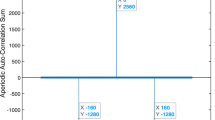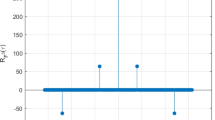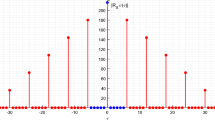Abstract
Sequences with low peak-to-average power ratio (PAPR) and desirable lengths are useful and important for orthogonal frequency division multiplexing (OFDM) systems. In this paper, based on the generalized Boolean functions (GBFs), a class of q-ary Z-complementary sequence sets (ZCSSs) and a class of complementary sequence sets (CSSs) are constructed. The obtained new ZCSSs and CSSs have low PAPR and non-power-of-two lengths.


Similar content being viewed by others
References
Golay, M.J.E.: Static multislit spectrometry and its application to the panoramic display of infrared spectra. J. Opt. Soc. Amer. 41(7), 468–472 (1951)
Spasojevic, P., Georghiades, C.N.: Complementary sequences for ISI channel estimation. IEEE Trans. Inf. Theory 47(3), 1145–1152 (2001)
Li, S., Wu, H., Jin, L., Wei, S.: Construction of compressed sensing matrix based on complementary sequence. In: IEEE 17th International Conference on Communication Technology (ICCT), Chengdu, pp 23–27 (2017)
Pezeshki, A., Calderbank, A.R., Moran, W., Howard, S.D.: Doppler resilient Golay complementary waveforms. IEEE Trans. Inf. Theory 54(9), 4254–4266 (2008)
Davis, J.A., Jedwab, J.: Peak-to-mean power control in OFDM, Golay complementary sequences and Reed-Muller codes. IEEE Trans. Inf. Theory 45(7), 2397–2417 (1999)
Budišin, S.: New complementary pairs of sequences. Electron. Lett. 26(13), 881–883 (1990)
Budišin, S., Spasojevic, P.: Paraunitary generation/correlation of QAM complementary sequence pairs. Cryptography Commun. 6(1), 59–102 (2014)
Ma, D.X., Wang, Z.L., Gong, G., Li, H.: A new method to construct Golay complementary set by paraunitary matrices and Hadamard matrices. In: 9th International Conference on Sequences and Their Applications (SETA-2016), pp 1–12 (2016)
Borwein, P.B., Ferguson, R.A.: A complete description of Golay pairs for lengths up to 100. Math. Comput. 73, 967–985 (2003)
Tseng, C.C., Liu, C.L.: Complementary sets of sequences. IEEE Trans. Inf. Theory 18(5), 644–652 (1972)
Paterson, K.G.: Generalized Reed-Muller codes and power control in OFDM modulation. IEEE Trans. Inf. Theory 46(1), 104–120 (2000)
Welti, G.: Quaternary codes for pulsed radar. IRE Trans. Inf. Theory 6(3), 400–408 (1960)
Wang, S.Q., Abdi, A.: Aperiodic complementary sets of sequences-based MIMO frequency selective channel estimation. IEEE Commun. Lett. 9 (10), 891–893 (2005)
Wang, S., Abdi, A.: MIMO ISI channel estimation using uncorrelated Golay complementary sets of polyphase sequences. IEEE Trans. Vehi. Techno. 56(5), 3024–3040 (2007)
Jeon, H., Lee, J., Han, Y., Kim, S.J., Kweon, I.S.: Multi-image deblurring using complementary sets of fluttering patterns. IEEE Trans. Image Proc. 26(5), 2311–2326 (2017)
Chen, C.Y.: Complementary sets of non-power-of-two length for peak-to-average power ratio reduction in OFDM. IEEE Trans. Inf. Theory 62(12), 7538–7545 (2016)
Aparicio, J., Shimura, T.: Asynchronous detection and identification of multiple users by multi-carrier modulated complementary set of sequences. IEEE Access 6, 22054–22069 (2018)
Fan, P.Z., Yuan, W.N., Tu, Y.F.: Z-complementary binary sequences. IEEE Signal Proc. Lett. 14(8), 509–512 (2007)
Liu, Z.L., Parampalli, U., Guan, Y.L.: Optimal odd-length binary Z-complementary pairs. IEEE Trans. Inf. Theory 60(9), 5768–5781 (2014)
Lee, W.: Mobile Communications Design Fundamentals. Wiley, Hoboken (2010)
Liu, Z.L., Guan, Y.L.: 16-QAM almost-complementary sequences with low PMEPR. IEEE Trans. Commun. 64(2), 668–679 (Jan. 2016)
Yu, N.Y., Gong, G.: Near-complementary sequences with low PMEPR for peak power control in multicarrier communications. IEEE Trans. Inf. Theory 57(1), 505–513 (2011)
Chen, C.Y., Wang, C.H., Chao, C.C.: Complementary sets and Reed-Muller codes for peak-to-average power ratio reduction in OFDM. In: Proc. 16th AAECC Lect. Notes Comput. Sci., vol. 3857, pp 317–327 (2006)
Chen, C.Y., Wang, C.H., Chao, C.C.: Complete complementary codes and generalized Reed-Muller codes. IEEE Commun. Lett. 12(11), 849–851 (2008)
Chen, W., Tellambura, C.: Identifying a class of multiple shift complementary sequences in the second order cosets of the first order Reed-Muller codes. In: IEEE Int. Conf. Commun., vol. 1, Seoul, South Korea, pp. 618–621 (2005)
Schmidt, K.-U.: Complementary sets, generalized Reed-Muller codes, and power control for OFDM. IEEE Trans. Inf Theory 53(2), 808–814 (2007)
Chen, C.Y.: A novel construction of complementary sets with flexible lengths based on Boolean functions. IEEE Commun. Lett. 22(2), 260–263 (2018)
Adhikary, A.R., Majhi, S.: New constructions of complementary sets of sequences of lengths non-power-of-two. IEEE Commun. Lett. 23(7), 1119–1122 (2019)
Wang, G.X., Adhikary, A.R., Zhou, Z.C., Yang, Y.: Generalized constructions of complementary sets of sequences of lengths non-power-of-two. IEEE Signal Proc. Lett. 27, 136–140 (2020)
Shen, B.S., Yang, Y., Zhou, Z.C.: A construction of binary Golay complementary sets based on even-shift complementary pairs. IEEE Access 8, 29882–29890 (2020)
Pai, C.Y., Chen, C.Y.: Construction of complementary sequence sets based on complementary pairs. IEEE Access 56(8), 966–968 (2020)
Liu, Z.L., Parampalli, U., Guan, Y.L.: On even-period binary Z-complementary pairs with large ZCZs. IEEE Signal Process. Lett. 21(3), 284–287 (2014)
Liu, Z.L., Parampalli, U., Guan, Y.L.: Optimal odd-length binary Z-complementary pairs. IEEE Trans. Inf. Theory 21(3), 284–287 (2014)
Chen, C.Y.: A novel construction of Z-complementary pairs based on generalized Boolean functions. IEEE Signal Process. Lett. 24(7), 284–287 (2017)
Adhikary, A.R., Majhi, S., Liu, Z.L., Guan, Y.L.: New sets of even-length binary Z-complementary pairs with asymptotic ZCZ ratio of 3/4. IEEE Signal Process. Lett. 25(7), 970–973 (2018)
Xie, C.L., Sun, Y.J.: Constructions of even-period binary Z-complementary pairs with large ZCZs. IEEE Signal Process. Lett. 25(8), 1141–1145 (2018)
Shen, B.S., Yang, Y., Zhou, Z.C., Fan, P.Z., Guan, Y.L.: New optimal binary Z-complementary pairs of odd length 2m+ 3. IEEE Signal Proc. Lett. 26(12), 1931–1934 (2019a)
Shen, B.S., Yang, Y., Zhou, Z.C., Zhou, Y.J.: New constructions of binary (near) complementary sets. In: The 9th International Workshop on Signal Design and its Applications in Communications (IWSDA’19), October 20-24 Dongguan, China, pp 1–5 (2019b)
Adhikary, A.R., Sarkar, P., Majhi, S.: A direct construction of q-ary even length Z-complementary pairs using generalized Boolean functions. IEEE Signal Process. Lett. 27, 146–150 (2020)
Pai, C.Y., Majhi, S., Shing, W.W., Chen, C.Y.: Z-complementary pairs with flexible lengths from generalized Boolean functions. IEEE Commun. Lett. 24(6), 1183–1187 (2020)
Gu, Z., Zhou, Z.C., Wang, Q., Fan, P.Z.: New construction of optimal Type-II binary Z-complementary pairs. IEEE Trans. Inf. Theory, Early Access Article (2021)
Yu, T., Du, X.Y., Li, L.P., Yang, Y.: Constructions of even-length Z-complementary pairs with large zero correlation zones. IEEE Signal Proc. Lett. 28, 828–831 (2021)
Sarkar, P., Roy, A., Majhi, S.: Construction of Z-complementary code sets with non-power-of-two lengths based on generalized Boolean functions. IEEE Commun. Lett. 24(8), 1607–1611 (2020)
Acknowledgments
The authors are very grateful to the reviewers and the Associate Editor for their valuable comments and suggestions that improved the presentation and quality of this paper. This work of B.S. Shen, Y. Yang and Z.C. Zhou was supported in part by the NSFC Project No. 62171389 and 62131016. The work of Pingzhi Fan was supported by the NSFC project No. 62020106001 and the 111 project No. 111-2-14.
Author information
Authors and Affiliations
Corresponding author
Additional information
Publisher’s note
Springer Nature remains neutral with regard to jurisdictional claims in published maps and institutional affiliations.
This paper was presented in part at the 2019 Ninth International Workshop on Signal Design and its Applications in Communications (IWSDA) [38]
Rights and permissions
About this article
Cite this article
Shen, B., Yang, Y., Fan, P. et al. New z-complementary/complementary sequence sets with non-power-of-two length and low PAPR. Cryptogr. Commun. 14, 817–832 (2022). https://doi.org/10.1007/s12095-021-00550-7
Received:
Accepted:
Published:
Issue Date:
DOI: https://doi.org/10.1007/s12095-021-00550-7
Keywords
- Orthogonal frequency division multiplexing (OFDM)
- Peak-to-average power ratio (PAPR)
- Z-complementary sequence set
- Complementary sequence set
- Generalized Boolean function




